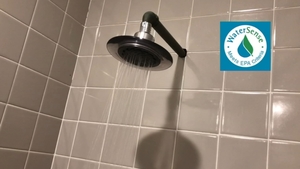Here’s a quick quiz: What’s the biggest energy expense in your house? If you guessed heating and cooling, you’re right. Here’s the good news: The second biggest expense: heating water for laundry, washing dishes and bathing, can be brought way down with these simple tips from Consumer Reports.
How long do you spend in a hot shower? Nearly 20-percent of water used in the average household comes out of the shower. A standard showerhead releases 2.5 gallons of water a minute.
Consumer Reports says that replacing with a low-flow Watersense-approved head that uses 2-gallons per-minute or less can save you 2,900-gallons a year.
And a few habit changes can make a big difference. — First, try a shorter shower. And quit letting the water run when shaving or brushing your teeth.
After scraping, there is no need to rinse dishes before putting them in the dishwasher. You’re essentially cleaning them twice, and you could cause the dishwasher’s sensors to adjust to a lighter wash and not get them clean.
For best results and energy savings, always run your dishwasher fully loaded. And consider replacing your old dishwasher. New, energy efficient models us as little as 4-gallons per-load.
Ninety percent of your clothes washer’s energy goes to heating the water. Using warm water instead of hot for your laundry can cut a load’s energy use in half. And using cool water will save even more. Consumer Reports tests showed your clothes will still get clean.
“Because energy-efficient washers operate at cooler temperatures, detergents have been reformulated to do a fine job in cool water,” said Emilio Gonzalez of Consumer Reports.
And a word about leak from faucets, shower heads or toilets. One drip per second wastes nearly 1,700-gallons of water a year. That’s a lot of short showers.
Speaking of the cost of leaks, here’s one last tip from Consumer Reports. To find out if your toilet is leaking, put a few drops of food coloring into the tank. In 10 minutes, if there is color in the bowl – you’ve got a leak. Time to fix or replace it.
All Consumer Reports material Copyright 2017 Consumer Reports, Inc. ALL RIGHTS RESERVED. Consumer Reports is a not-for-profit organization which accepts no advertising. It has no commercial relationship with any advertiser or sponsor on this site. For more information visit consumerreports.org







